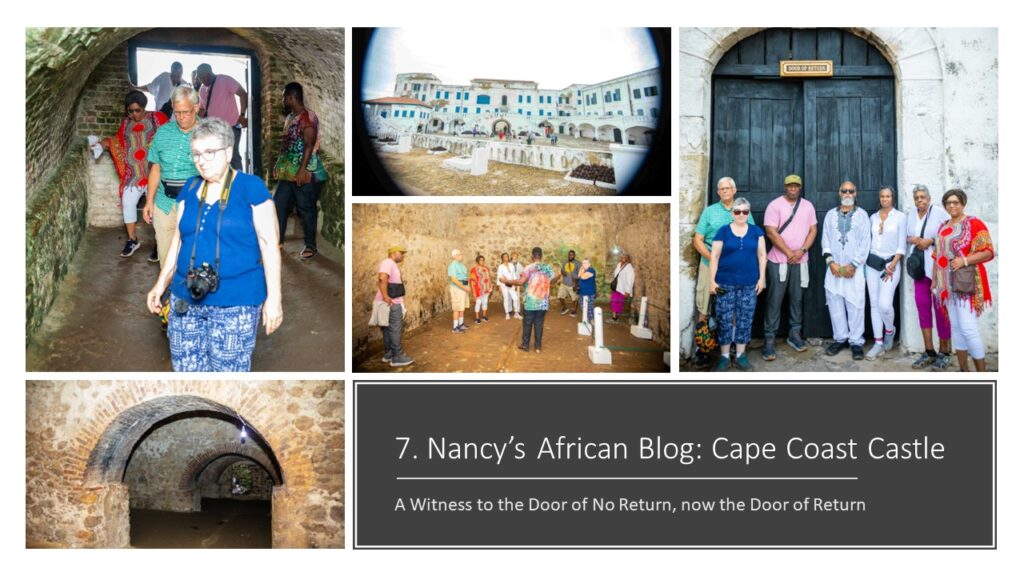
7: Nancy’s African Blog: Cape Coast Castle
On Day 3 in Ghana, after witnessing the Naming Ceremony and a hike in the tree canopy at Kakum National Park, we traveled to Cape Coast Castle on the Atlantic Ocean. This foreboding 400-year-old structure now stands quietly by the sea, welcoming tourists like me. I come to fathom the past reality of this place, to understand the history so I can be a witness, someday bringing this awful truth alive in my writing.
This castle represents a very ugly chapter in the history of my country. Some people now want to erase it from our history books and/or sugar coat the atrocity. I want to experience it personally, so I can more effectively speak, write and act to end the racism that started with the slave trade.
The Cape Coast Castle took 300 years to build and is one of 40 castles along the African coast built by Europeans as holding cells for Africans captured to be slaves in the Americas.
A tour guide led us down into male and female dungeons. During the slave trade, hundreds of Africans were cramped into these poorly ventilated rooms for two weeks to three months, awaiting the slave ships. Only 1 out of 5 survived the dungeons. Archaeologists have identified the layer of brown stone-like material over the original floor to be composed of packed and decayed body excrements and organic matter from those imprisoned Africans.
I hated these dungeons. I felt claustrophobic, trying to imagine the horrific experience for the Africans, trapped there for weeks without sanitation, exercise, adequate food and light. I felt numb and sad, angry and bewildered. How could those Europeans treat human beings this way?
In the dungeon, we participated in a candle lighting ceremony for the ancestors. A musician in our group offered a song of tribute. Memorial Wreaths placed in one corner also remembered the Africans who suffered here. We gathered around a small altar for them to learn.
Our guide told us that worship services were held in the rooms above the dungeons. They created a heaven above hell, perhaps they thought he told us. I wondered how. How could any Christian engage in such evil?
Although the practice of slavery began thousands of years before, the magnitude and cruelty of the African slave trade was unprecedented. Europeans traded Africans for various items, including guns. African rulers captured and traded other people from neighboring tribes and spoils of wars.
An estimated 10-14 million Africans were kidnapped and sold as labor for plantations in the Americas. First the Portuguese, then later the French, English and Dutch participated in this horrible enterprise, treating human beings as less than cattle. During the colonial period, the Europeans also captured and controlled most of the entire continent of Africa, taking the resources and using the people for their own profit.
The holding dungeons and slave ships were intentionally developed to weed out the weak. Only the strong survived. If they survived the slave dungeons, at least 20% more died on the ships to America. Most of the Africans were shipped to the Caribbean and South America. Only 388,000 were sold in the American colonies, of what is now the United States of America.
We walked through the “Door of No Return.” The ancestral Africans who walked through that door never returned to their homeland. They were shackled together, then layered into slave ships, enduring horrendous conditions on the trip to the Americas.
In 2019, Ghanaian officials added a new sign on the ocean side of this door. Now “The Door of Return” welcomes the descendants of African slaves who come to page homage to their ancestral home. On our tour, the tribal elders completed the Naming Ceremony started earlier in our day. Libations were offered, an elder washed the feet of the returning descendants, embraced them and handed each a certificate with their new African names.
I’m writing this blog to pay tribute to these African ancestors with this blog. I wrote my book Revelation in the Roots: Emerald Isle to pay tribute to them as well. I am continuing to write novels to expose and address this grave injustice.
I believe it’s very important to talk about race and to become anti-racist in our words and actions. You can listen to some Talking About Race interviews I’ve done with others on YouTube about why it’s so important to talk about race.
I hope you will join me in speaking up and working against the practices of racism that continue in our country, 400 years later.
